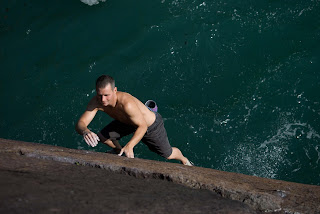It wasn’t long after I had posted this link on UKC (under 5 minutes!) that my phone rang. It was Mick Ryan from UKC, he had already sent me written warning about posting links to my blog, without a commercial profile that costs £200. Bearing in mind that the present financial crisis has seemed to devastate the outdoor industry, which as only a small part of the rural economy passes under the mainstream media radar. Meaning that the only £200 I am likely to spend is on rent or food.
However, Mick’s only wanted to point out that actually UKC aren’t killing magazine, instead he offered the hypothesis that an inability to move with the times is leading to there downfall. Fortunately Mick liked the blog, and said a few things that as an industry outsider I had only guest at, but it seemed some of my guesses where right on the money. Like the BBC though I do feel that in the interest of balance and fairness, I should perhaps take up Mick’s challenge of saying why UKC isn’t destroying print media, and maybe lay into climber magazine a wee bit.
Now the big advantage magazines have over the Internet is that they have a budget to pay for content, meaning they have authors that work professionally within the adventure field. Now for some like Ed Douglas and Jim Perrin, who have both made full time careers out of writing for both climbing and mainstream media, so as such you get a polished product. However other authors are less professional, I cite myself in this bunch, when I was writing area reports for OTE and CLIMB, but there are certainly other writers who fit this category.
An argument from the heavy weights of climbing literati is that idiots like me shouldn’t be allowed the space to publish, as amateurs, we simply pollute their industry. Now generally I would agree with this however, my personal preference is for Douglas articles, which use interviews and research, rather than say Perrin’s approach which is to quote long dead climbers, and dredge his mind for some experience he may or may not have had in the long distant past, when climbing was proper, unlike this modern pish that we call climbing today. If I was an editor Perrin would be relegated to Walking World by now.
So whilst the magazine can pay for content the question is, is it the right content, for me it is not, but for others it might be what the doctor order. So someone more senior than me may find Perrin’s writing interesting and informative. Now the demographic of climbing has changed, and I suspect that with a generally ageing population with higher amounts of disposable incomes to, well dispose of on magazines, means that Perrin will be offering the SAGA column for a few years yet.
On top of authors, magazine also pay for images, as such you expect that they would have better images than UKC. I have kept images off the Internet to allow me a better chance of getting them published in magazines. Only when they don’t sell do I put them on UKC. However, looking at the last few Perrin articles, what we get is one of Ray Wood’s ageing collection of climbing images, often ones we all saw a few years ago. Often each is aged by a harness, rock boots, rucksack or lack of stubble on a young climbers face. In defence of Ray he does a very good job in the main of knocking out new images every month for Panton’s Stone Circle’s, if you want a training tip, then go on a photo shoot with Ray.
Lastly writing for the Internet, is an art in itself, in that most online blogging sites recommend no more than 500 words per item, as people tend to click away after that. Meaning that any news is often just the headlines and a small amount of detail, this does allow print media further and more in-depth coverage. As well as short and sweet, often web writing, and this is one thing UKC aren’t that guilty of to be honest is keeping up key word density. Where search engines now use a combination of keyword, keyword density and online clout (how many visitor the site gets) to rate how high up the search list an article or webpage comes, after all one of the keys to successful web writing is being discoverable through the main search engines (Google and Yahoo). Fortunately UKC already has a captive audience, and a massive online clout.






